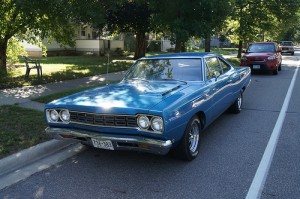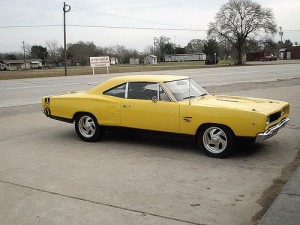1968 Plymouth Roadrunner & Dodge Super Bee
Mopar’s challenge to the Ford Mustang and the Chevy Camaro
The late sixties was the heyday for Classic American Muscle cars. Ford started the ball rolling in 1964 with the Mustang. GM jumped onto the bandwagon with the Chevrolet Camaro 1967 and the race was on.
Not to be outdone, the two Mopar divisions, Dodge and Plymouth both launched their own muscle cars – the Plymouth Roadrunner and the Dodge Super Bee in 1968. Although both budget muscle cars were popular, the Roadrunner was more the more successful of the two.
1968 Plymouth Roadrunner

Plymouth reportedly paid Warner Brothers $50,000 for the privilege of affixing decals of a quite famous cartoon bird to the sides of its cars. Perhaps the brass at Plymouth figured that that was what it took to stay ahead of the Camaros and Mustangs. The Roadrunner was based on the Plymouth Belvedere pillared coupe (a hardtop coupe was offered mid-year). The Roadrunner’s main attraction was the $2,895 base price. The low sticker price was made even more attractive by the high performance that came with it – Mopar’s 383 cid engine putting out 335 hp. This tried and true powerplant was treated to the heads, manifolds, camshafts, valve springs and induction system from the 440 Magnum. The power was transmitted to the ground via a beefed-up suspension and a manual transmission. Owners who wanted more oomph could fork over $714 and get the legendary 426 Hemi slid into the engine bay. The Hemi engine bumped horsepower up to a pavement smoking 425!
With most of the money spent on the powerplant the interior suffered. A simple bench seat and plain rubber mats was all that greeted the driver.
If it was performance that the buyer was after, the Roadrunner did not disappoint. The stock 383 delivered seven second 0-60 times and did the 1/4 mile in 15 seconds at a speed of 96 mph. The Hemi got performance hungry drivers 5.3 second 0-60 times and 1/4 mile times of about 13.5 seconds doing 105 mph.
Buyers must have agreed with the math as they snatched up approximately 45,000 cars in its first year. The factory had conservatively forecasted for 2,500. Maybe the horn that went “beep-beep” had something to do with it.
1968 Dodge Super Bee

Dodge engaged in a bit of rivalry with Plymouth when they brought out their own budget muscle car. The Dodge Super Bee was based on the Dodge Coronet coupe which shared the same chassis as its sister, the Plymouth Belvedere. Instead of spending $50,000 for a name, Dodge looked for inspiration to its Scat Pack symbol in coming up with the Super Bee designation.
The Super Bee’s base price was $3,027, just $132 more than the Roadrunner. The two shared the same drivetrain so weight and performance were about the same. The four barrel carb was mated with a four-speed transmission and a Hurst Competition Plus shifter. The car rode on red line wide oval tires. The optional 425 horsepower 426 Hemi was a whopping (for 1968 anyway) $1,000 more than the base 383 so only 125 were actually ordered. To differentiate itself from the Road, Runner Dodge dipped into the corporate parts bin and came up with the Rallye gauge package from the Charger. Still, a tachometer was a $38 option.
The Super Bee celebrated its name with Bumble Bee racing stripes circling the tail and a big Super Bee emblem on the rear quarter panels. The grille was matte black and the hood sported a decorative power bulge. No chance anybody could mistake this for any other muscle car!
The interior was one-up from the Roadrunner with wall-to-wall carpeting to go with the bench seats.
Total production for the Super Bee for 1968 was a modest 7,842.





